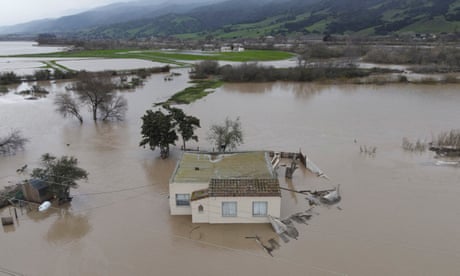- by foxnews
- 17 Nov 2024
California’s rainstorm hell ‘among the most deadly disasters in our history’
California’s rainstorm hell ‘among the most deadly disasters in our history’
- by theguardian
- 17 Jan 2023
- in news

As more dangerous storms bear down on California, the state is only just beginning to grapple with the destruction and death left by weeks of extreme weather that wreaked havoc in nearly every region from the northern coast to Los Angeles.
The series of storms that have pummeled California since late December have killed at least 19 people, brought hurricane force winds that toppled trees and power lines, cutting energy to thousands, and flooded roads and rivers, covering swaths of land in dense mud and debris that stretches for miles. Entire communities have been forced to evacuate while road closures and power disruptions left some rural regions isolated and almost cut off from the outside world.
Authorities are still documenting the toll of the disaster, an effort that's been hampered by a fresh onslaught of more storms. Joe Biden has approved emergency declarations from 41 of California's 58 counties.
"These storms are among the most deadly natural disasters in the modern history of our state," Nancy Ward, the director of the governor's office of emergency services said at a briefing on Friday.
After a grueling drought and California's driest years on record, the latest turn of extreme weather, which some experts have called hydrological "whiplash", has highlighted the challenges that come with such a rapid deluge, particularly in a state more accustomed in recent years to disasters related to heat and wildfire.
California has received an average of more than 9in of rainfall since late December and some areas have already seen the amount of rain they typically get in the entire year, according to the National Weather Service.
But one of the greatest impacts from the recent weather is also the intense and widespread wind damage that far exceeds that seen during typical wind events, climate scientist Daniel Swain said in a video update on Friday. In central California's Calaveras county, a tornado with 90mph winds uprooted a barn.
"This has been a deadly storm sequence. The damage will probably be at least in the hundreds of millions if not higher before all is said and done," Swain said. "And the disruption to people, even people who have stayed relatively safe - there are a lot of folks who have been without power and without road access to where they live for a long time."
The damage wrought by the storms could be seen in central California's San Luis Obispo county where search and rescue teams have spent days trying to find a missing five-year-old boy who disappeared in floodwaters. In photos posted online, the sheriff's office showed the thick mud, brush piles and debris teams have trudged through while searching for Kyle Doan.
Doan was swept away after floodwaters overtook the car he was traveling in with his mother. There were no signs on the road warning of closures, his father told the Guardian, and water rapidly overtook the vehicle, pulling it toward a nearby creek. As the pair evacuated the vehicle, the currents pulled the kindergartner from his mother's arms and forced her underwater. Residents were able to rescue Lindsy Doan with a rope, but the water quickly carried Kyle away before rescuers could get to him.
"Days have now gone by, we still haven't found him yet," Brian Doan said on Thursday. "We went over there today about a mile downstream from where my wife was picked up and you can just see the aftermath the water receded there's just so much debris that was wrapped around trees."
The storms also highlighted the grave risks extreme weather poses to more than 116,000 people living outdoors in the state. Two unhoused people in Sacramento died earlier this month when trees fell on to their tents.
"It's horrifying. You've got 7,000 people or more trying to survive the rain and high winds. The little survival gear they have - it gets blown away pretty easily," Bob Erlenbusch, the executive director of the Sacramento Regional Coalition to End Homelessness, told the Guardian. "People get wet, their belongings get wet. These are really difficult conditions."
The impacts of the storms have been far-reaching. More than 96,000 people were placed under evacuation orders or warnings as the National Weather Service issued flood watches for roughly 90% of the state's sprawling population. Hundreds of harrowing water rescues had to be performed by emergency workers as submerged streets shuttered highways and other transportation corridors.
On the central coast, more than 10,000 people were ordered to evacuate seaside towns last week, including all of Montecito - the wealthy community that is home to Prince Harry, Oprah Winfrey and other celebrities. Officials in Santa Barbara shut down schools and public transit systems due to the extreme weather. Further south in Los Angeles, a sinkhole swallowed two cars and flooded a downtown transit hub.
The storm also caused a sewage spill of more than 14m gallons into the Ventura River, prompting authorities to post warning signs along the river and beaches.
Workers with Cal Trans have spent recent weeks clearing trees, rocks and mud from state highways after the storms closed as many as 60 roads. "We're doing everything we can to keep the highways open," the department's deputy director Michael Keever said Friday.
With rain expected through the week, authorities are warning Californians to listen to local officials, stay aware of their surroundings and not attempt to drive or walk in water - just 6in of fast-moving water can knock over and carry an adult while just a foot of water can carry away a small car.
"We're not out of the woods - we expect these storms to continue at least through the middle of next week with a minimum of three more atmospheric rivers hitting our state," Governor Gavin Newsom said as he toured the damage in Santa Cruz, just south of the Bay Area. "California is soaked and even an inch more of rain can bring catastrophic impacts like flooding and mudslides."
The rains did do some good, offering a reprieve from the state's devastating drought conditions. Reservoir levels rose significantly this week and the snowpack swelled significantly, which will secure the state's water resources through the spring and summer. But new dangers lurk in the seasons ahead. Vegetation seeded during these winter storms can quickly turn to wildfire fuel when the weather warms and dries.
For now, the sodden state waits in anticipation for drier days, when the immense cleanup process can commence.
- by foxnews
- descember 09, 2016
New hotels for family-friendly travel in America, from Florida to Tennessee and more
Newly opened U.S. hotels in Florida, South Carolina and other states could provide endless fun for families no matter the season. Check out these 10 family-friendly oases.
read more


